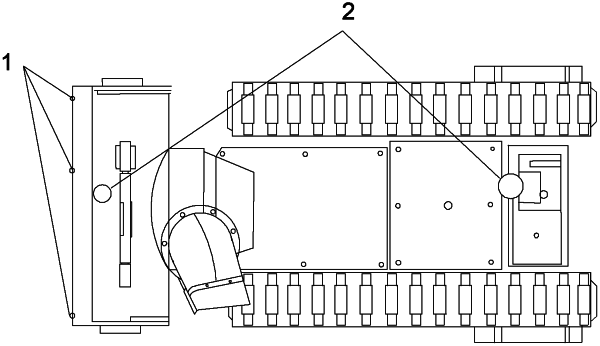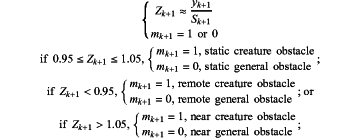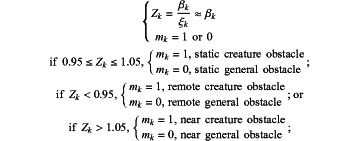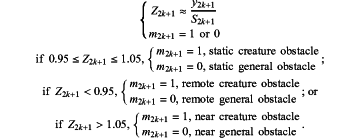| CPC G05D 1/0214 (2013.01) [E01H 5/04 (2013.01); G01N 29/00 (2013.01); G01S 15/00 (2013.01); G05D 1/0255 (2013.01); G05D 1/0257 (2013.01)] | 1 Claim |

|
1. A method for obstacle detection and recognition for an intelligent snow sweeping robot, comprising the following steps:
(1) disposing a first, second, and third ultrasonic sensor on a left side, middle, and a right side of a front end of the snow sweeping robot, respectively, to detect a distance between the snow sweeping robot and an obstacle ahead by the first, second, and third ultrasonic sensors; and sweeping robot operates at a constant velocity; and in this case, x increases, the snow sweeping robot enters a section with a small snow cover extent, and the obstacle determining conditions are as follows:
 focusing on a first fraction yk+1/Sk+1 because of a second fraction Sk/yk≈1 on the right-hand side of the equation, in this case, Sk+1 increases, and the obstacle determining conditions are as follows:
 detecting that any of the ultrasonic sensors has a detection distance d>dflag and ν−νflag>νdiffer, an expression of S2k+1<S2k holds at a moment 2k+1, and
S2k and y2k at a moment 2k are equal to those at a previous moment 2k−1 at which the snow sweeping robot works at a constant velocity; and in this case, x decreases, the snow sweeping robot enters a section with a large snow cover extent, and the obstacle determining conditions are as follows:
disposing a first and second radar sensor at the front and rear parts of the snow sweeping robot, respectively, to detect whether a creature suddenly approaches when the snow sweeping robot operates by the first and second radar sensors;
(2) processing signals detected by each of the first, second, and third ultrasonic sensors and each of the first and second radar sensors, and calculating a forward distance of the snow sweeping robot, comprising:
a. processing distance data detected by each ultrasonic sensor, comprising:
performing recursive weighted average filtering on distance data detected by each ultrasonic sensor within a time period Δt, expressed as follows for a kth time period Δt:
 wherein dk represents a measurement for kth ultrasonic ranging, dki represents a distance value obtained in ith detection within the kth time period Δt, ρki represents a weight value for the ith detection, and n represents a number of detected distance values within the kth time period Δt;
b. processing the signals detected by each radar sensor, comprising:
processing the signals acquired by each radar sensor within the kth time period Δt, expressed as follows:
 wherein mk represents a result obtained after the signal acquired by the each radar sensor within the kth time period Δt is processed; and
c. calculating the forward distance of the snow sweeping robot, comprising:
performing amplitude-limiting filtering on forward velocities of the snow sweeping robot within the kth time period Δt, expressed as follows:
 wherein νj represents a forward velocity of the snow sweeping robot converted from data which is read for the jth time from an encoder detecting a wheel velocity of the snow sweeping robot, represents a forward velocity of the snow sweeping robot converted from data which is read for the (j−1)th time from the encoder detecting the wheel velocity of the snow sweeping robot, νres represents a maximum deviation between the two velocities, Sk represents a forward distance of the snow sweeping robot within the kth time period Δt, p represents a number of times the encoder data of the snow sweeping robot is read within the time period Δt, and t represents a short time period; and
(3) detecting and recognizing the obstacle, comprising:
defining a descriptive statistic of a snow cover extent as follows:
 wherein α represents a predetermined scale factor, and ν represents a forward velocity of the snow sweeping robot, and in other words, the snow cover extent is inversely proportional to the forward velocity of the snow sweeping robot;
defining a measurement variation for kth ultrasonic ranging as follows:
 defining a measurement variation for kth ultrasonic ranging as follows:
 defining a variation ratio of the forward distance of the snow sweeping robot within the kth time period Δt as follows:
 establishing obstacle determining conditions as follows:
 detecting that any of the ultrasonic sensors has a detection distance d>dflag and |ν−νflag|≤νdiffer, dflag representing a standard safe distance, νflag representing a standard forward velocity of the snow sweeping robot, and νdiffer representing a threshold of a forward velocity difference of the snow sweeping robot, S1≈S2≈ . . . ≈Sk and the snow cover extent x is approximately constant, that is, the snow sweeping robot operates at a constant velocity in a section with a uniform snow cover extent, and the obstacle determining conditions are degenerated as follows:
 detecting that any of the ultrasonic sensors has a detection distance d>dflag and ν−νflag>νdiffer, an expression of Sk+1>Sk holds at a moment k+1, and Sk and yk at a moment k are equal to those at a previous moment k−1 at which the snow
 focusing on a first fraction y2k+1/S2k+1 because of a second fraction S2k/y2k≈1 on the right-hand side of the equation, in this case, S2k+1 decreases, and the obstacle determining conditions are as follows:
 (4) detecting that any of the ultrasonic sensors has a detection distance that is not d>dflag;
selecting an active obstacle avoidance strategy in response to detecting the detection distance that is not d>dflag; and
performing obstacle avoidance based on the selected active obstacle avoidance strategy.
|